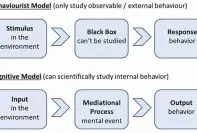The feeling of discomfort which is caused by holding two alternate beliefs is described with the term cognitive dissonance.
People like to feel that they are consistent with their beliefs or what they understand to be true. But what happens when they engage in a different belief or are involved in actions that are completely opposite of their previous belief. That is when Cognitive Dissonance occurs.
The feeling of discomfort is referred to as dissonance and something must change in order to reduce the dissonance caused by two conflicting beliefs.
Festinger’s Theory and Definition
Leon Festinger was one of the first psychologists to research on Cognitive Dissonance. As a part of his study, he began an observation study of a cult whose members believed that earth was going to be destroyed by a flood. He then investigated how the cult members reacted when the flood did not actually happen.
Cult members who did not have any concrete belief regarding the matter realized that they had made a fool of themselves and they recognized it as putting it down to experience.
On the other hand, committed members of the cult who had gone as far as to give up their homes and jobs to work for the cult were not easily convinced. In fact, they went on to re-interpret the evidence of the flood not occurring due to the result of the faithfulness of the cult members.
In his book A theory of Cognitive Dissonance, Festinger defined cognitive dissonance as, “Cognitive dissonance can be seen as an antecedent condition which leads to activity oriented toward dissonance reduction just has hunger leads toward activity oriented toward hunger reduction.”
While this is definitely a different form of motivation than psychologists are used to dealing with, it’s certainly a powerful one. This has provided further explanation by Festinger’s Principle of Cognitive Consistency.
The theory states that we, as human beings possess an inner drive to hold all our beliefs and attitudes in consistency and avoid any sort of inconsistency or disharmony (i.e. dissonance).
Examples of Cognitive Dissonance
If we look close enough cognitive dissonance occurs in many areas of life. By definition, when our behavior conflicts our belief, cognitive dissonance occurs.
Example 1: An environmentalist who wants to preserve the environment.
Let’s suppose someone is an environmentalist who wants to preserve the environment advocates it and all that, but he drives a fancy car that does not have good mileage. Here, while his behavior of driving a car is completely opposite of what he stands for. This causes cognitive dissonance.
In order to reduce the dissonance between his behavior and the belief, he has to make a few choices leading towards reduction of dissonance. He can sell the car to ride a bicycle or use public transport, which would be changing the behavior in order to reduce dissonance.
Example 2: Smoking is injurious to health.
Leon Festinger also offered an example of an individual dealing with cognitive dissonance because of his behavior affecting his health. Consider an individual who smokes, now, he knows smoking is unhealthy and might cause cancer. But he doesn’t stop smoking, why?
The individual might argue that there are plenty of risks in day-to-day life and he cannot avoid every possible risk. Or, he might deem the behavior worth it in comparison to the stress and frustration he relieves because of it.
In this example, the smoker is able to reduce dissonance but also continue the behavior.
Factors Affecting Cognitive Dissonance
The level of dissonance felt is influenced by several factors. The degree in which a belief is valued or the level of disharmony caused by the behavior are major influencers.
The strength of dissonance also has contributing factors.
- Beliefs about the self causes a higher degree of cognitive dissonance.
- When a certain belief is highly valued, any inconsistency in that belief can lead to stronger dissonance.
- The strength of dissonance directly impacts the pressure to relieve the feelings of discomfort.
While behaviors cause cognitive dissonance, dissonance itself can highly impact the behaviors and actions of the individual.
How to Reduce Dissonance
Festinger’s theory of cognitive dissonance can be broken down into two parts.
Any behavior causing inconsistency in one’s beliefs causes dissonance. And, when a person experiences dissonance, he tries to lower those feelings of discomfort.
There are three key ways to reduce dissonance.
- Gaining new information that outweighs dissonant belief or behavior
An environmentalist driving a fancy car with high gas emission (see example 1) might research on the connection between greenhouse gases and global warming. The new information he obtains works as a supportive belief to lower dissonance. - Reduce the importance of conflicting belief
A man who smokes knowing smoking is injurious to health (see example 2) might try to justify his behavior by believing that his morning run makes up for his smoking habits. It’s more like trying to balance out the effects of inconsistent behavior with other activities which leads to the reduction of dissonance. - Changing the Belief Itself
When a person is willing to change the belief itself there lies no more question of cognitive dissonance. However, it’s easier said than done. And it’s even more difficult when the belief is held highly and the believer is a committed one.
Cognitive dissonance also has a huge effect on marketing. To learn more, visit Cognitive dissonance in Marketing.
A word from Psychestudy
Cognitive dissonance can play a major role in the decisions we make in life, and making the right decisions is directly impacted by how well do we understand Cognitive Dissonance.
An example of a positive effect of dissonance can be that,
Let’s say you believe taking candy off your daily diet is healthy, but you are so easily tempted by it. This causes discomfort and you experience cognitive dissonance. Now, you might start decreasing the number of candies you eat in order to maintain harmony between your beliefs and your behavior. Thus, understanding the theory of cognitive dissonance can have a positive impact on your life.





